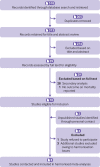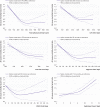Dose-response associations between accelerometry measured physical activity and sedentary time and all cause mortality: systematic review and harmonised meta-analysis
- PMID: 31434697
- PMCID: PMC6699591
- DOI: 10.1136/bmj.l4570
Dose-response associations between accelerometry measured physical activity and sedentary time and all cause mortality: systematic review and harmonised meta-analysis
Abstract
Objective: To examine the dose-response associations between accelerometer assessed total physical activity, different intensities of physical activity, and sedentary time and all cause mortality.
Design: Systematic review and harmonised meta-analysis.
Data sources: PubMed, PsycINFO, Embase, Web of Science, Sport Discus from inception to 31 July 2018.
Eligibility criteria: Prospective cohort studies assessing physical activity and sedentary time by accelerometry and associations with all cause mortality and reported effect estimates as hazard ratios, odds ratios, or relative risks with 95% confidence intervals.
Data extraction and analysis: Guidelines for meta-analyses and systematic reviews for observational studies and PRISMA guidelines were followed. Two authors independently screened the titles and abstracts. One author performed a full text review and another extracted the data. Two authors independently assessed the risk of bias. Individual level participant data were harmonised and analysed at study level. Data on physical activity were categorised by quarters at study level, and study specific associations with all cause mortality were analysed using Cox proportional hazards regression analyses. Study specific results were summarised using random effects meta-analysis.
Main outcome measure: All cause mortality.
Results: 39 studies were retrieved for full text review; 10 were eligible for inclusion, three were excluded owing to harmonisation challenges (eg, wrist placement of the accelerometer), and one study did not participate. Two additional studies with unpublished mortality data were also included. Thus, individual level data from eight studies (n=36 383; mean age 62.6 years; 72.8% women), with median follow-up of 5.8 years (range 3.0-14.5 years) and 2149 (5.9%) deaths were analysed. Any physical activity, regardless of intensity, was associated with lower risk of mortality, with a non-linear dose-response. Hazards ratios for mortality were 1.00 (referent) in the first quarter (least active), 0.48 (95% confidence interval 0.43 to 0.54) in the second quarter, 0.34 (0.26 to 0.45) in the third quarter, and 0.27 (0.23 to 0.32) in the fourth quarter (most active). Corresponding hazards ratios for light physical activity were 1.00, 0.60 (0.54 to 0.68), 0.44 (0.38 to 0.51), and 0.38 (0.28 to 0.51), and for moderate-to-vigorous physical activity were 1.00, 0.64 (0.55 to 0.74), 0.55 (0.40 to 0.74), and 0.52 (0.43 to 0.61). For sedentary time, hazards ratios were 1.00 (referent; least sedentary), 1.28 (1.09 to 1.51), 1.71 (1.36 to 2.15), and 2.63 (1.94 to 3.56).
Conclusion: Higher levels of total physical activity, at any intensity, and less time spent sedentary, are associated with substantially reduced risk for premature mortality, with evidence of a non-linear dose-response pattern in middle aged and older adults.
Systematic review registration: PROSPERO CRD42018091808.
Published by the BMJ Publishing Group Limited. For permission to use (where not already granted under a licence) please go to http://group.bmj.com/group/rights-licensing/permissions.
Conflict of interest statement
Competing interests: All authors have completed the ICMJE uniform disclosure form and declare: no support from any organisation for the submitted work; no financial relationships with any organisations that might have an interest in the submitted work in the previous three years; no other relationships or activities that could appear to have influenced the submitted work.
Figures


Comment in
-
Designing society to encourage activity.BMJ. 2019 Sep 26;366:l5691. doi: 10.1136/bmj.l5691. BMJ. 2019. PMID: 31558436 No abstract available.
-
The miracle cure.BMJ. 2019 Sep 26;366:l5759. doi: 10.1136/bmj.l5759. BMJ. 2019. PMID: 31558482 No abstract available.
-
Physical activity differs with sex and age.BMJ. 2019 Sep 30;366:l5694. doi: 10.1136/bmj.l5694. BMJ. 2019. PMID: 31570410 No abstract available.
References
-
- 2018 Physical Activity Guidelines Advisory Committee. 2018 Physical Activity Guidelines Advisory Committee Scientific Report. U.S. Department of Health and Human Services, 2018.
-
- Lee IM, Shiroma EJ, Lobelo F, Puska P, Blair SN, Katzmarzyk PT, Lancet Physical Activity Series Working Group Effect of physical inactivity on major non-communicable diseases worldwide: an analysis of burden of disease and life expectancy. Lancet 2012;380:219-29. 10.1016/S0140-6736(12)61031-9 - DOI - PMC - PubMed
Publication types
MeSH terms
Grants and funding
- BHF_/British Heart Foundation/United Kingdom
- R01 CA047988/CA/NCI NIH HHS/United States
- U01 CA182913/CA/NCI NIH HHS/United States
- R01 AG047645/AG/NIA NIH HHS/United States
- R01 CA154647/CA/NCI NIH HHS/United States
- HHSN268201500001I/HL/NHLBI NIH HHS/United States
- R01 HL043851/HL/NHLBI NIH HHS/United States
- RC1 HL099355/HL/NHLBI NIH HHS/United States
- N01HC25195/HL/NHLBI NIH HHS/United States
- R01 HL080467/HL/NHLBI NIH HHS/United States
- UM1 CA182913/CA/NCI NIH HHS/United States
- R01 HL136266/HL/NHLBI NIH HHS/United States
- R01 HL131029/HL/NHLBI NIH HHS/United States
